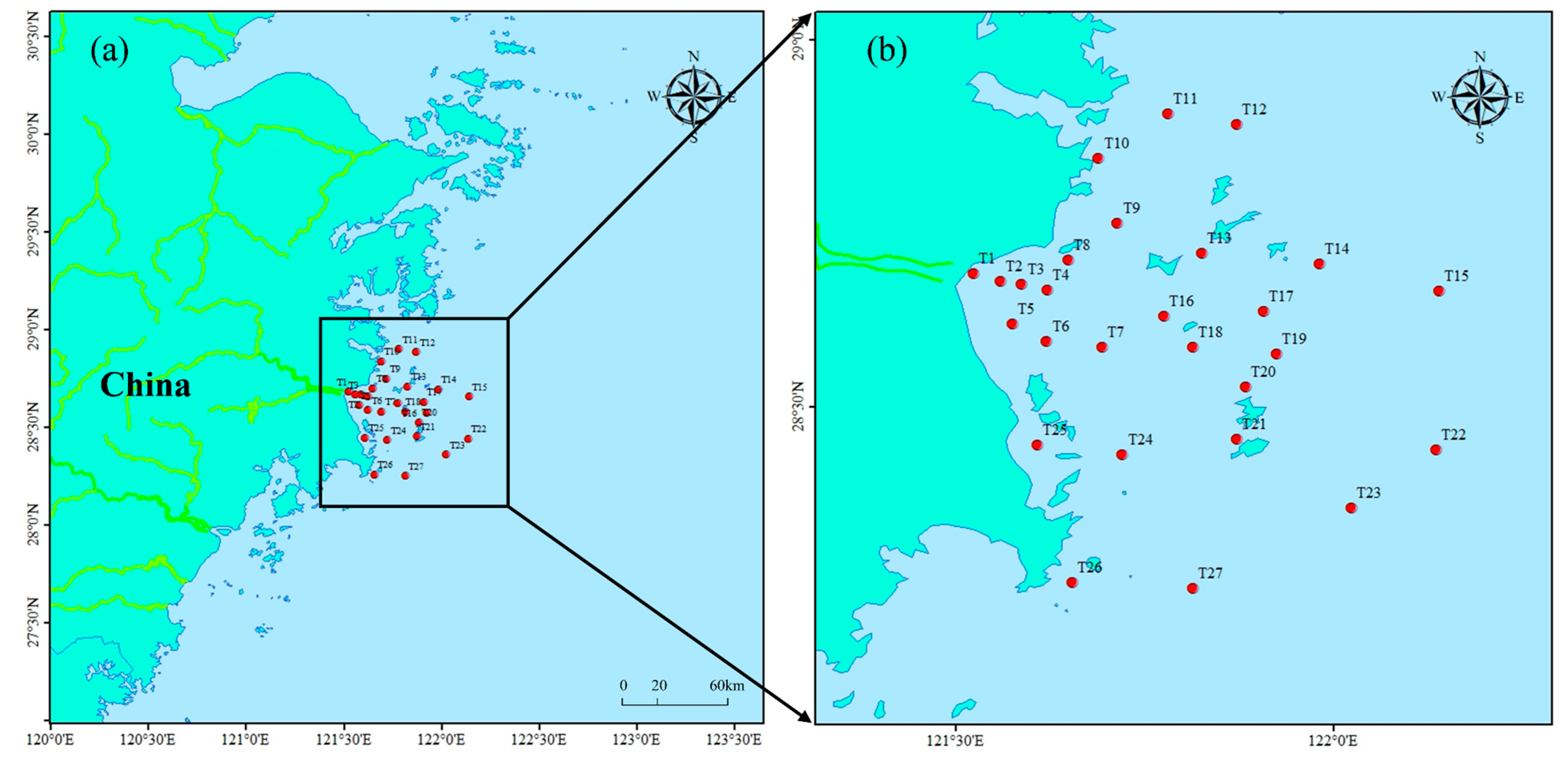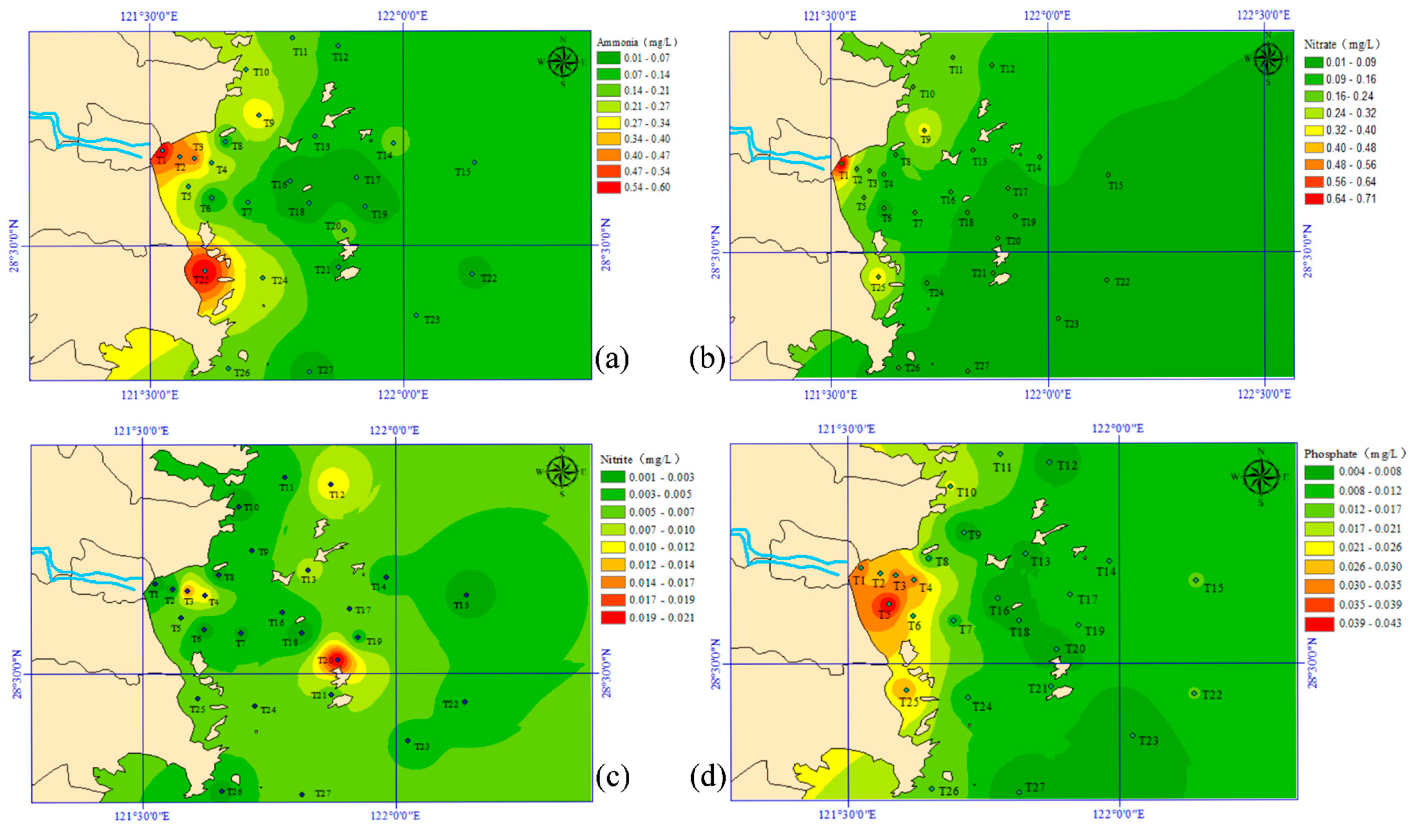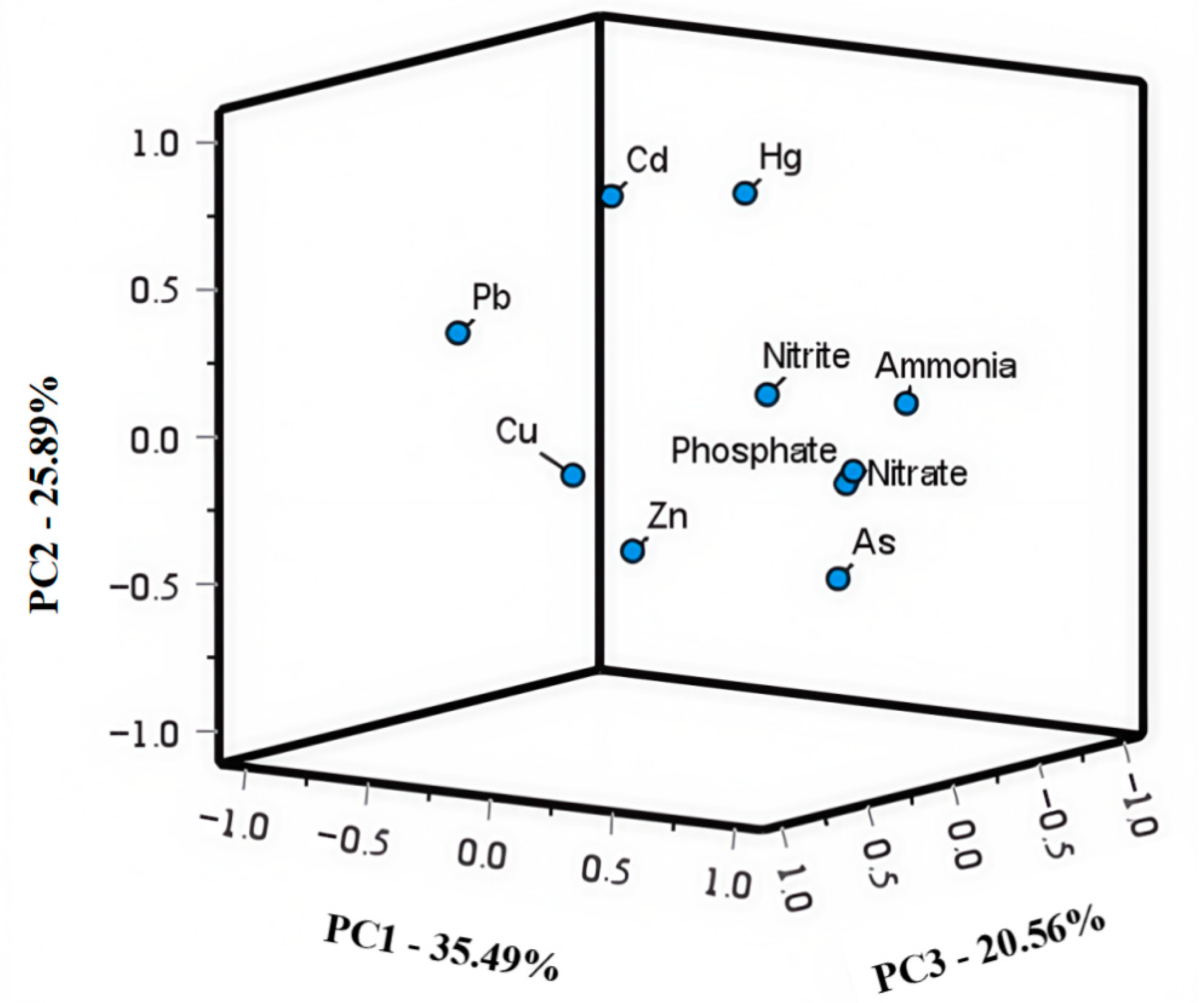Risk Assessment of Heavy Metals, Nitrogen, and Phosphorus in Seawater of Taizhou Bay, China
Abstract
1. Introduction
2. Materials and Methods
2.1. Sample Collection and Analysis
2.2. Heavy Metal Pollution Assessment
3. Results and Discussion
3.1. Characteristics of Seawater Property and Distribution of Heavy Metals
3.2. Risk Assessment of Heavy Metals
3.3. Correlation Between Heavy Metals and Inorganic Pollutants
3.4. Source Identification of Contaminants in Seawater
4. Conclusions
Author Contributions
Funding
Institutional Review Board Statement
Informed Consent Statement
Data Availability Statement
Conflicts of Interest
References
- Camacho-Jimenez, L.; Gonzalez-Ruiz, R.; Yepiz-Plascencia, G. Persistent organic pollutants (POPs) in marine crustaceans: Bioaccumulation, physiological and cellular responses. Mar. Environ. Res. 2023, 192, 106184. [Google Scholar] [CrossRef] [PubMed]
- Liu, Y.; Lian, Z.; Li, F.; Majid, A.; Wang, J. Review on molecular imprinting technology and its application in pre-treatment and detection of marine organic pollutants. Mar. Pollut. Bull. 2021, 169, 112541. [Google Scholar] [CrossRef]
- Ibrahim, I.A.; Rawindran, H.; Alam, M.M.; Leong, W.H.; Sabirin, N.T.; Ng, H.-S.; Chan, Y.J.; Abdelfattah, E.A.; Lim, J.W.; Aliyu, U.S.A.; et al. Mitigating persistent organic pollutants from marine plastics through enhanced recycling: A review. Environ. Res. 2024, 240, 117533. [Google Scholar] [CrossRef] [PubMed]
- Li, J.; Zhang, W.; Ding, J.; Xue, S.; Huo, E.; Ma, Z.; Yu, W.; Jiang, Z.; Fang, J.; Mao, Y. Effect of large-scale kelp and bivalve farming on seawater carbonate system variations in the semi-enclosed Sanggou Bay. Sci. Total Environ. 2021, 753, 142065. [Google Scholar] [CrossRef] [PubMed]
- Arikibe, J.E.; Prasad, S. Determination and comparison of selected heavy metal concentrations in seawater and sediment samples in the coastal area of Suva, Fiji. Mar. Pollut. Bull. 2020, 157, 111157. [Google Scholar] [CrossRef]
- Liu, H.; Zhao, B.; Jin, M.; Wang, R.; Ding, Z.; Wang, X.; Xu, W.; Chen, Q.; Tao, R.; Fu, J.; et al. Anthropogenic-induced ecological risks on marine ecosystems indicated by characterizing emerging pollutants in Pearl River Estuary, China. Sci. Total Environ. 2024, 926, 172030. [Google Scholar] [CrossRef]
- Pasciucco, E.; Pasciucco, F.; Castagnoli, A.; Iannelli, R.; Pecorini, I. Removal of heavy metals from dredging marine sediments via electrokinetic hexagonal system: A pilot study in Italy. Heliyon 2024, 10, e27616. [Google Scholar] [CrossRef]
- Kong, D.; Yao, J.; Li, X.; Luo, J.; Yang, M. A reusable AuNPS with increased stability applied for fast screening of trace heavy metals in edible and medicinal marine products. Ecotoxicol. Environ. Saf. 2020, 204, 111107. [Google Scholar] [CrossRef]
- Li, C.; Zhang, Y.; Chen, R.; Wang, N.; Liu, J.; Liu, F. Influence of mineralized organic carbon in marine sediments on ecological heavy metal risk: Bohai Bay case study. Environ. Res. 2024, 240, 117542. [Google Scholar] [CrossRef]
- Liu, B.; Lv, L.; An, M.; Wang, T.; Li, M.; Yu, Y. Heavy metals in marine food web from Laizhou Bay, China: Levels, trophic magnification, and health risk assessment. Sci. Total Environ. 2022, 841, 156818. [Google Scholar] [CrossRef]
- Gopal, V.; Krishnamurthy, R.R.; Sreeshma, T.; Chakraborty, P.; Nathan, C.S.; Kalaivanan, R.; Anshu, R.; Magesh, N.S.; Jayaprakash, M. Effect of a tropical cyclone on the distribution of heavy metals in the marine sediments off Kameswaram, Southeast coast of India. Mar. Pollut. Bull. 2021, 171, 112741. [Google Scholar] [CrossRef]
- Shi, C.; He, H.; Xia, Z.; Gan, H.; Xue, Q.; Cui, Z.; Chen, J. Heavy metals and Pb isotopes in a marine sediment core record environmental changes and anthropogenic activities in the Pearl River Delta over a century. Sci. Total Environ. 2022, 814, 151934. [Google Scholar] [CrossRef] [PubMed]
- Hao, Z.; Qian, J.; Zheng, F.; Lin, B.; Xu, M.; Feng, W.; Zou, X. Human-influenced changes in pollution status and potential risk of sediment heavy metals in Xincun Bay, a typical lagoon of Hainan, China. Mar. Pollut. Bull. 2024, 199, 115949. [Google Scholar] [CrossRef]
- Colozza, N.; Gravina, M.F.; Amendola, L.; Rosati, M.; Akretche, D.E.; Moscone, D.; Arduini, F. A miniaturized bismuth-based sensor to evaluate the marine organism Styela plicata bioremediation capacity toward heavy metal polluted seawater. Sci. Total Environ. 2017, 584–585, 692–700. [Google Scholar] [CrossRef]
- Zhao, Y.; Wu, J.; Kang, X.; Peng, J.; Ding, H.; Ning, J.; Sheng, X.; Tan, Z. Seasonal variations of heavy metals in seawater and integrated poly-cultured scallop Chlamys farreri in Ailian Bay, northern China. Mar. Pollut. Bull. 2023, 186, 114465. [Google Scholar] [CrossRef]
- Caglayan, C.; Taslimi, P.; Turk, C.; Gulcin, I.; Kandemir, F.M.; Demir, Y.; Beydemir, S. Inhibition effects of some pesticides and heavy metals on carbonic anhydrase enzyme activity purified from horse mackerel (Trachurus trachurus) gill tissues. Environ. Sci. Pollut. Res. 2020, 27, 10607–10616. [Google Scholar] [CrossRef]
- Kirici, M. Toxic effects of copper sulphate pentahydrate on antioxidant enzyme activities and lipid peroxidation of freshwater fish Capoeta umbla (Heckel, 1843) tissues. Appl. Ecol. Environ. Res. 2017, 15, 1685–1696. [Google Scholar] [CrossRef]
- He, J.; Zhang, X.; Zhou, Y.; Jia, Y.; Su, S. Phosphate and amphiphilic-functionalized luffa with anti-biofouling property for efficient uranium extraction from seawater. Mater. Lett. 2024, 358, 135763. [Google Scholar] [CrossRef]
- Yang, M.; Zhao, L.; Yu, X.; Shu, W.; Cao, F.; Liu, Q.; Liu, M.; Wang, J.; Jiang, Y. Microbial community structure and co-occurrence network stability in seawater and microplastic biofilms under prometryn pollution in marine ecosystems. Mar. Pollut. Bull. 2024, 199, 115960. [Google Scholar] [CrossRef] [PubMed]
- Liu, X.Z.; Liu, Q.Q.; Sheng, Y.Q. Nutrients in overlying water affect the environmental behavior of heavy metals in coastal sediments. Environ. Res. 2023, 238, 117135. [Google Scholar] [CrossRef]
- Ming, H.X.; Zan, S.J.; Liu, J.W.; Su, J.; Ren, K.J.; Lin, J.N.; Chen, Q.R.; Shi, Y.Y.; Shi, T.T.; Fan, J.F. Promoting the denitrification process by heavy metals in Liaohe Estuary sediment. Mar. Pollut. Bull. 2024, 203, 116408. [Google Scholar] [CrossRef]
- GB/T 12763-2007; The Specifications for Oceanographic Survey. General Administration of Quality Supervision, Inspection and Quarantine of the People’s Republic of China: Beijing, China, 2007.
- GB 17378-2007; The Specification for Marine Monitoring. General Administration of Quality Supervision, Inspection and Quarantine of the People’s Republic of China: Beijing, China, 2007.
- Xu, F.; Liu, Z.; Cao, Y.; Qiu, L.; Feng, J.; Xu, F.; Tian, X. Assessment of heavy metal contamination in urban river sediments in the Jiaozhou Bay catchment, Qingdao, China. Catena 2017, 150, 9–16. [Google Scholar] [CrossRef]
- GB 3097-1997; The Sea Water Quality Standard. Ministry of Environmental Protection of the People’s Republic of China: Beijing, China, 1997.
- Hou, W.; Wang, Q.; Xiang, Z.; Jia, N.; Hu, J.; Wu, Z.; Dong, W. Comprehensive assessment of occurrence, temporal-spatial variations, and ecological risks of heavy metals in Jiaozhou Bay, China: A comprehensive study. Mar. Pollut. Bull. 2024, 198, 115883. [Google Scholar] [CrossRef] [PubMed]
- Chai, L.; Wang, Y.; Wang, X.; Ma, L.; Cheng, Z.; Su, L. Pollution characteristics, spatial distributions, and source apportionment of heavy metals in cultivated soil in Lanzhou, China. Ecol. Indic. 2021, 125, 107507. [Google Scholar] [CrossRef]
- Han, Q.F.; Zhao, S.; Zhang, X.R.; Wang, X.L.; Song, C.; Wang, S.G. Distribution, combined pollution and risk assessment of antibiotics in typical marine aquaculture farms surrounding the Yellow Sea, North China. Environ. Int. 2020, 138, 105551. [Google Scholar] [CrossRef]
- Hoeven, N.V.D. Estimating the 5-percentile of the species sensitivity distributions without any assumptions about the distribution. Ecotoxicology 2001, 10, 25–34. [Google Scholar] [CrossRef]
- Zhang, J.; Zhou, F.; Chen, C.; Sun, X.; Shi, Y.; Zhao, H.; Chen, F. Spatial distribution and correlation characteristics of heavy metals in the seawater, suspended particulate matter and sediments in Zhanjiang Bay, China. PLoS ONE 2018, 13, 201414. [Google Scholar] [CrossRef]
- Peng, S. The nutrient, total petroleum hydrocarbon and heavy metal contents in the seawater of Bohai Bay, China: Temporal-spatial variations, sources, pollution statuses, and ecological risks. Mar. Pollut. Bull. 2015, 95, 445–451. [Google Scholar] [CrossRef]
- Xu, H.; Yang, H.; Ge, Q.; Jiang, Z.; Wu, Y.; Yu, Y.; Han, D.; Cheng, J. Long-term study of heavy metal pollution in the northern Hangzhou Bay of China: Temporal and spatial distribution, contamination evaluation, and potential ecological risk. Environ. Sci. Pollut. Res. 2021, 28, 10718–10733. [Google Scholar] [CrossRef]
- Tian, K.; Wu, Q.; Liu, P.; Hu, W.; Huang, B.; Shi, B.; Zhou, Y.; Kwon, B.O.; Choi, K.; Ryu, J.; et al. Ecological risk assessment of heavy metals in sediments and water from the coastal areas of the Bohai Sea and the Yellow Sea. Environ. Int. 2020, 136, 105512. [Google Scholar] [CrossRef]
- Wang, X.; Zhong, L.; Zhang, H.; Li, D.; Xu, K.; Zhou, Y. Dissolved metal assessment in surface seawater: A spatial-seasonal evaluation in the Zhejiang coastal waters, the East China Sea. Mar. Pollut. Bull. 2022, 185, 114226. [Google Scholar] [CrossRef] [PubMed]
- Wei, S.; Fu, D.; Wang, D.; Yu, G.; Luo, Y.; Xu, H. Tracer study of CDOM for nitrogen and phosphorus pollution in the offshore Leizhou Peninsula, China. Ecol. Indic. 2023, 148, 110019. [Google Scholar] [CrossRef]
- Li, Z.; Qi, R.; Li, Y.; Miao, J.; Li, Y.; He, Z.; Zhang, N.; Pan, L. The assessment of bioavailability and environmental risk of dissolved and particulate polycyclic aromatic hydrocarbons in the seawater of typical bays. Sci. Total Environ. 2024, 912, 169124. [Google Scholar] [CrossRef]
- Meng, X.; Chen, S.; Li, D.; Song, Y.; Sun, L. Identification of marine microplastics based on laser-induced fluorescence and principal component analysis. J. Hazard. Mater. 2024, 465, 133352. [Google Scholar] [CrossRef]
- Liu, R.; Jiang, W.; Li, F.; Pan, Y.; Wang, C.; Tian, H. Occurrence, partition, and risk of seven heavy metals in sediments, seawater, and organisms from the eastern sea area of Shandong Peninsula, Yellow Sea, China. J. Environ. Manag. 2021, 279, 111771. [Google Scholar] [CrossRef]
- Jafarabadi, A.R.; Bakhtiyari, A.R.; Toosi, A.S.; Jadot, C. Spatial distribution, ecological and health risk assessment of heavy metals in marine surface sediments and coastal seawaters of fringing coral reefs of the Persian Gulf, Iran. Chemosphere 2017, 185, 1090–1111. [Google Scholar] [CrossRef] [PubMed]
- Jin, Y.; Du, J.; Sun, Y.; Wang, E.; Yan, W. Source and pollution assessment of heavy metals in surface sediments of Laoshan Bay, South Yellow Sea, China. Mar. Pollut. Bull. 2023, 197, 115691. [Google Scholar] [CrossRef] [PubMed]





| Region | Cu | Pb | Zn | Cd | Hg | As | Ref. |
|---|---|---|---|---|---|---|---|
| Zhanjiang Bay, China | 4.00 | 0.25 | 16.74 | 0.08 | / | / | [30] |
| Bohai Bay, China | 0.16–7.17 | 0.17–9.55 | 17.3–90 | 0.02–0.68 | 0.003–0.36 | 0.25–4.02 | [31] |
| Hangzhou Bay, China | 2.13–4.59 | 0.21–0.48 | 7.81–20.34 | 0.05–0.28 | 0.03–0.09 | 1.08–2.57 | [32] |
| Yellow sea, China | 74.56 | 1.65 | 13.47 | 0.2 | / | 33.80 | [33] |
| East sea, China | 0.10–6.40 | 0.16–3.60 | 2.50–24.0 | / | 0.001–0.11 | 0.85–4.20 | [34] |
| Taizhou Bay, China | 1.87–3.65 | 0.10–0.95 | 2.98–16.80 | 0.07–0.38 | 0.011–0.043 | 0.93–2.06 | This work |
| Heavy Metals | Cu | Pb | Zn | Cd | Hg | As | DIN | Phosphate |
|---|---|---|---|---|---|---|---|---|
| SFI | 0.54 | 0.34 | 0.43 | 0.19 | 0.53 | 0.08 | 1.15 | 0.53 |
| PN | 0.66 | 0.71 | 0.67 | 0.30 | 0.72 | 0.09 | 0.96 | 0.03 |
| RQ | 3.88 | 0.01 | 1.67 | 0.89 | 0.10 | 15.11 | / | / |
| pH | Salinity | COD | Nitrate | Nitrite | Ammonia | Phosphate | Cu | Pb | Zn | Cd | Hg | As | |
|---|---|---|---|---|---|---|---|---|---|---|---|---|---|
| pH | 1 | ||||||||||||
| Salinity | 0.125 | 1 | |||||||||||
| COD | −0.134 | −0.713 ** | 1 | ||||||||||
| Nitrate | −0.119 | −0.519 ** | 0.471 * | 1 | |||||||||
| Nitrite | −0.186 | 0.039 | −0.123 | −0.147 | 1 | ||||||||
| Ammonia | −0.394 * | −0.463 * | 0.483 * | 0.768 ** | 0.141 | 1 | |||||||
| Phosphate | 0.015 | −0.382 * | 0.655 ** | 0.450 * | −0.032 | 0.616 ** | 1 | ||||||
| Cu | −0.099 | −0.143 | 0.11 | 0.349 | −0.254 | 0.166 | 0.096 | 1 | |||||
| Pb | 0.058 | 0.533 ** | −0.338 | −0.367 | −0.072 | −0.32 | −0.169 | 0.462 * | 1 | ||||
| Zn | 0.365 | 0.021 | −0.07 | −0.366 | 0.324 | −0.298 | −0.117 | −0.173 | −0.057 | 1 | |||
| Cd | −0.282 | 0.295 | 0.036 | −0.199 | 0.04 | −0.033 | −0.129 | 0.091 | 0.409 * | −0.295 | 1 | ||
| Hg | −0.177 | 0.111 | −0.066 | −0.085 | 0.036 | 0.095 | −0.108 | −0.207 | 0.061 | −0.19 | 0.318 | 1 | |
| As | 0.012 | −0.693 ** | 0.429 * | 0.329 | 0.042 | 0.318 | 0.450 * | 0.067 | −0.471 * | −0.043 | −0.381 * | −0.21 | 1 |
| Parameter | PC1 | PC2 | PC3 |
|---|---|---|---|
| Nitrate | 0.842 | 0.281 | −0.001 |
| Nitrite | −0.061 | −0.411 | 0.397 |
| Ammonia | 0.813 | 0.232 | 0.323 |
| Phosphate | 0.719 | 0.079 | 0.030 |
| Cu | 0.180 | 0.612 | −0.592 |
| Pb | −0.555 | 0.570 | −0.292 |
| Zn | −0.275 | −0.674 | −0.216 |
| Cd | −0.383 | 0.602 | 0.382 |
| Hg | −0.183 | 0.268 | 0.739 |
| As | 0.679 | −0.304 | −0.135 |
| Eigenvalue | 3.549 | 2.589 | 2.056 |
| % of total variance | 35.491 | 25.893 | 20.560 |
| Cumulative % of variance | 35.491 | 61.384 | 81.940 |
Disclaimer/Publisher’s Note: The statements, opinions and data contained in all publications are solely those of the individual author(s) and contributor(s) and not of MDPI and/or the editor(s). MDPI and/or the editor(s) disclaim responsibility for any injury to people or property resulting from any ideas, methods, instructions or products referred to in the content. |
© 2025 by the authors. Licensee MDPI, Basel, Switzerland. This article is an open access article distributed under the terms and conditions of the Creative Commons Attribution (CC BY) license (https://creativecommons.org/licenses/by/4.0/).
Share and Cite
Xia, G.; Han, C.; Chen, M.; Wang, G.; Lu, K.; Zhu, J.; Yao, J. Risk Assessment of Heavy Metals, Nitrogen, and Phosphorus in Seawater of Taizhou Bay, China. J. Xenobiot. 2025, 15, 143. https://doi.org/10.3390/jox15050143
Xia G, Han C, Chen M, Wang G, Lu K, Zhu J, Yao J. Risk Assessment of Heavy Metals, Nitrogen, and Phosphorus in Seawater of Taizhou Bay, China. Journal of Xenobiotics. 2025; 15(5):143. https://doi.org/10.3390/jox15050143
Chicago/Turabian StyleXia, Guanghua, Chunling Han, Manting Chen, Guanjie Wang, Kejia Lu, Jianqiang Zhu, and Jiachao Yao. 2025. "Risk Assessment of Heavy Metals, Nitrogen, and Phosphorus in Seawater of Taizhou Bay, China" Journal of Xenobiotics 15, no. 5: 143. https://doi.org/10.3390/jox15050143
APA StyleXia, G., Han, C., Chen, M., Wang, G., Lu, K., Zhu, J., & Yao, J. (2025). Risk Assessment of Heavy Metals, Nitrogen, and Phosphorus in Seawater of Taizhou Bay, China. Journal of Xenobiotics, 15(5), 143. https://doi.org/10.3390/jox15050143






